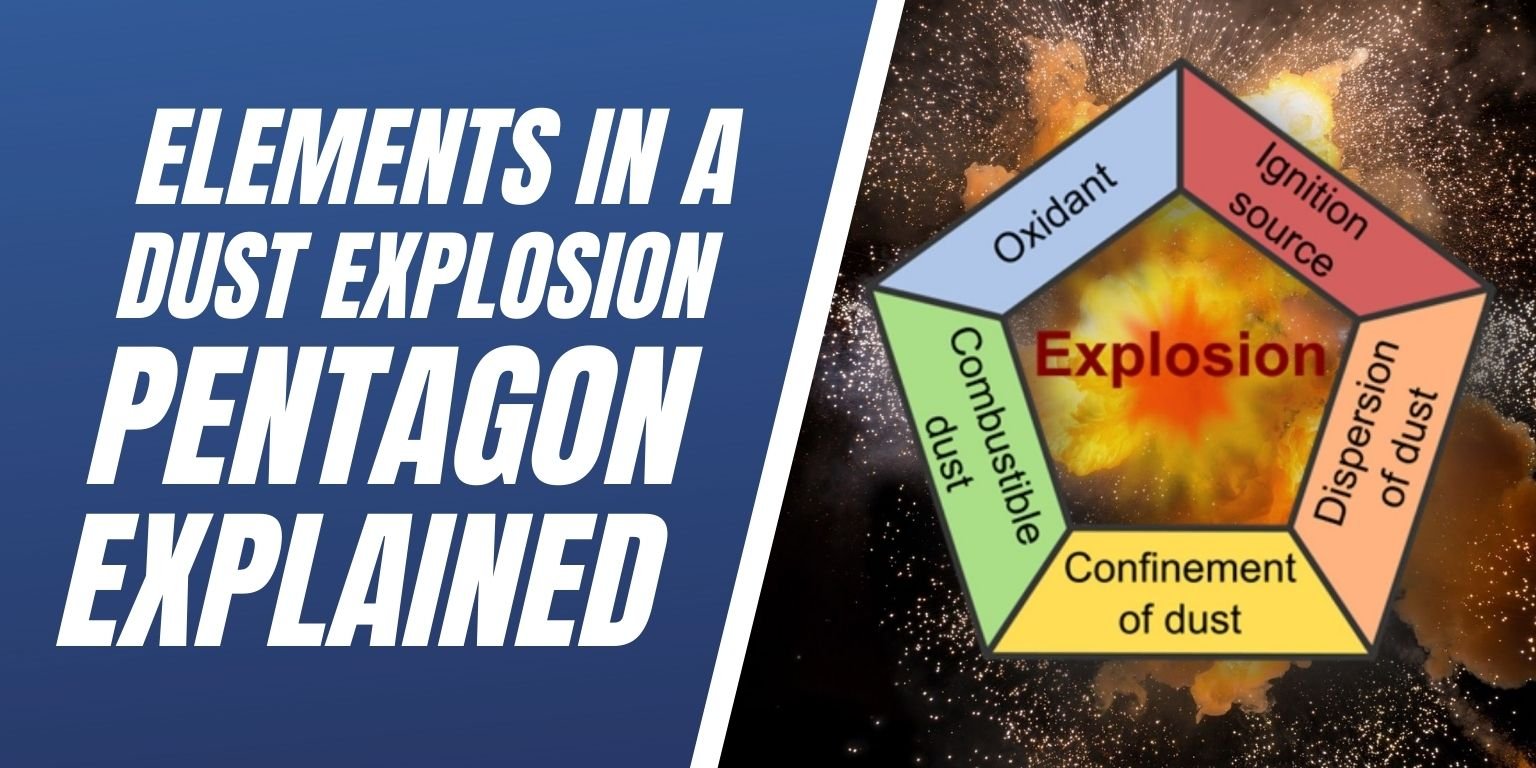
We all know that flammable solids will burn easily, but what many people may not realize is that dust can be even more flammable and explosive.
According to the National Fire Protection Association (NFPA) 654 defines combustible dust as “A combustible particulate solid that presents a fire or deflagration hazard when suspended in air or some other oxidizing medium over a range of concentrations, regardless of particle size or shape.”
For a fire to burn there are three elements needed simultaneously: Fuel, Ignition, and Oxygen – also known as the “Fire Triangle”. But for a combustible dust explosion, two additional elements are needed to form what is known as the “Dust Explosion Pentagon”. These two elements are Confinement and Dispersion.
Despite the universal use of the dust explosion pentagon in the safety industry, it doesn’t clearly illustrate the actions that must occur to turn a pile of dust into an explosion. This makes it difficult to believe that it can happen, which is why it continues to be an issue.
Elements of A Combustible Dust Explosion
Dust
It seems obvious that this would be necessary for a dust explosion, but often the dust that becomes the fuel for an explosion has accumulated on high-surface areas and is out of sight from most cleaning. This of course isn’t always the case- workers at Imperial Sugar had ankle deep layers of sugar throughout the building that helped fuel that explosion.
Over time this dust collects on surfaces, depending on what is produced in the building it can take anywhere from days to years to accumulate to dangerous levels. It can accumulate on rafters and pipes, inside ductwork, or on any other high surface that doesn’t get cleaned regularly.
Oxidant
Fire needs oxygen in order to burn, which can be found everywhere in most buildings. It can be found in the air you breathe, the pressurized air used for power tools, and closed rooms. This makes it the hardest aspect of the explosion pentagon to control and remove. Adding this step gives the dust the ability to actually burn.
Dispersion
When the pile of dust is just sitting there it doesn’t create much of an explosion hazard, even though it does create a fire hazard. It isn’t until the accumulated dust is dispersed throughout the oxidized air that it creates an explosion hazard.
The ways that this dust can become airborne and create a dust cloud are varied; it can be from air movement in the building, exhaust from machinery, using compressed air, or even from smaller fires or explosions nearby. This is why the NFPA standards for dust cleaning say not to use compressed air to remove dust from high surfaces; doing so will create an explosion hazard.
Confinement
While this step isn’t completely necessary for an explosion, it is what makes the industrial dust explosions so powerful and dangerous. When the dust cloud is confined in a closed area it does not have the air movement from wind to disperse it; dust particles can instead stay suspended in the air for days at a time. This allows the levels of dust particles in the air to increase and provide more fuel for the resulting explosion.
When the confined dust cloud does explode the confinement also forces the explosion to build pressure. This forces the explosion into corners of the building it wouldn’t have normally reached, and also forces it to push through the weakest areas of the building. This is how these explosions are able to blow roofs off buildings, or buckle concrete floors, or knock entire walls down. In the case of Imperial Sugar, the initial explosion was confined to hallways and tunnels, where it reached more rooms full of fuel, which resulted in numerous secondary explosions.
Ignition (Heat, Spark)
The airborne dust is nothing more than a dust cloud until it comes into contact with an ignition source. These ignition sources can vary, and what is needed to ignite the cloud depends on what the dust is made from. Some dusts can ignite just from touching hot machinery, while other dusts ignite after being exposed to a small fire, spark, static electricity, or even a lit cigarette.
Some materials, such as magnesium, are even able to create enough heat by themselves to self-ignite.
EXPLOSION!
Once all the requirements in the dust explosion pentagon have been met and the confined dust cloud comes into contact with an ignition source an explosion results. This is when each particle in the dust cloud burns and ignites the particles near it, causing the explosion to move from the ignition source outward through the cloud.
The confinement of the explosion can be compared to a cannon; the force of the explosion in the cannon is powerful enough to launch a cannonball for miles, and the force of the dust explosion is powerful enough to completely flatten otherwise strong buildings.
Unfortunately, not all elements of the dust explosion pentagon can be completely eliminated. However, combustible dust and its dispersion can be controlled with effective dust collection systems, strict observance of OSHA standards, and regular cleaning by certified and trained environmental professionals.
Hughes Environmental has performed combustible dust cleaning in a wide array of facilities throughout the United States and has dealt with many types of combustible dust. Our technicians are OSHA-trained and certified to remove combustible dust. Hughes uses equipment approved for combustible dust cleaning, such as intrinsically safe vacuums and grounded hoses.
Contact Us Here or call 888- 845-3952

